|
EXPRESS LOCOMOTIVE FOR THE CHICAGO, BURLINGTON & QUINCEY
R.R.
Engineering News—Dec., 1895
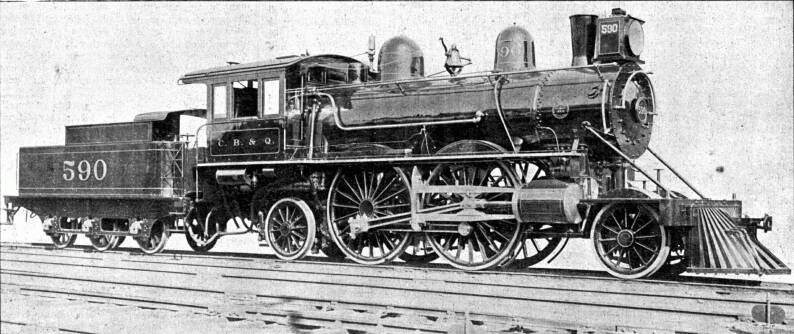
One of the notable departures from the ordinary types of express
engines is that known as, the "Columbia" type, which
has four driving wheels (of which the rear pair are the main drivers),
a two-wheel, or pony, leading truck, and a single, pair of trailing
wheels, which have 4-in. extra
play. This type of engine was first designed in 1891 by the Baldwin
Locomotive Works to meet the special requirements of the Philadelphia
& Reading R. R., as shown in our issue of Nov. 21, 1891. These
engines had the Wootten type of firebox, and one of them, illustrated
in our issue of June 15, 1893, was exhibited at the Columbian
Exhibition. All of these engines were Vauclain four-cylinder compounds,
and have given most excellent results in service. There was also
exhibited at the Columbian Exhibition a locomotive of similar
type, but with a narrower firebox, designed to burn bituminous
coal, and this engine, which attracted much attention, was named
the "Columbia," from which the name of this type of
engine has been derived. This engine has, since the close of the
exhibition, been run on several different roads, and has given
very excellent results.
A similar engine to the "Columbia," but single, expansion
instead of compound, has recently been built for the Chicago,
Burliugton & Quincy R. R. by order of Mr. O. W. Rhodes, Superintendent
of Motive Power. This engine is shown on our inset sheet this
week, and we are indebted to the Baldwin Locomotive Works for
drawings and specifications from which this article is prepared.
The engine has a very handsome appearance, and among its -striking
features may be noted the arrangement of wheels on both engine
and tender and the use of piston-valves on a simple engine, while
the size of the driving wheels—7 ft.—is unusual for
Western roads. The general dimensions and particulars of the engine
are as follows:
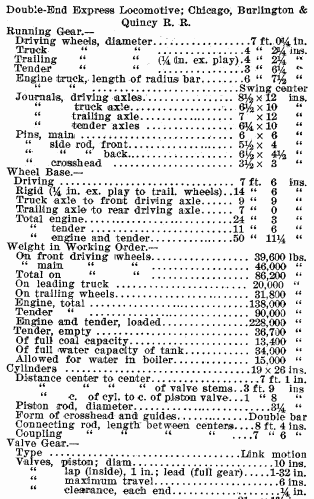 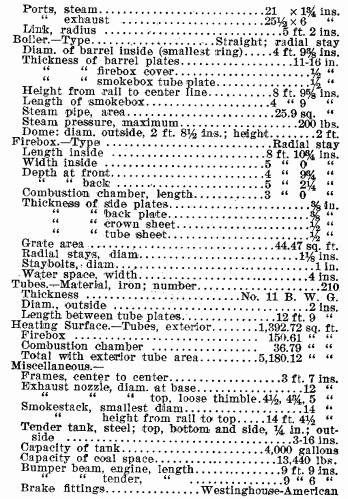
The frames are of steel, and are dropped at the rear end to carry
a deep firebox over the small trailing wheels. The boiler is made
of 11-16-in. steel flange plates, having all the longitudinal
seams butt jointed, with double covering strips calked inside
and outside. The throat sheet is 8
in. thicker than shell plates, to prevent undue thinning where
it is flanged. The waist is 58w
ins. diameter at the smokebox end, with a straight top, and having
a dome ring of pressed steel 1 in, thick. The firebox is of steel,
and has a combustion chamber 3 ft. long, in which is a firebrick
arch. The 18-in. radial stays
of the crown are screwed through the crown sheet and riveted over,
and all solid staybolts and stays have drilled ends. The firebox
is designed for burning soft coal, and has a grate of the rocking
and drop pattern, while the ashpan has front damper slides in
the bottom. The tubes are of iron, No. 11 B. W. G., with copper
ferules on the swaged ends in the firebox tube sheet. The smokebox
has an extension front, with wire netting, deflecting plate and
spark hopper, and a, straight smokestack is used. The feed is
supplied by two Sellers injectors. The cylinders are lagged with
wood and eased with iron, and the cylinder-head covers are of
hydraulic forged steel, polished and filled with asbestos. The
boiler is lagged with asbestos cement, and jacketed with cold-rolled
pickled steel (painted), with steel bands. The fittings include
two Richardson sealed safety valves, the teach sanding apparatus
and the West bellringer. The Jerome metallic packing is used on
piston-rods and valve stems.
The cylinders have piston slide valves fitted in the saddles,
as shown, an arrangement which is rather novel in simple engines,
although it has been tried recently in England, and the design
is very similar to that used in the Baldwin four-cylinder compound
engines. It will be seen by the list of dimensions that these
valves give a great port area. The pistons are of cast iron, with
piston rods of open-hearth steel fitted to the cast steel crossheads,
which have brass bearings. The cylinders and air pump are lubricated
by Nathan automatic sight-feed lubricators placed in the cab.
The connecting and side rods are of open-hearth steel, all of
I-section, and the side rods have solid ends with heavy
brass bushings put in by hydraulic pressure. The driving-boxes
are of steeled cast iron, with brass, bearings.
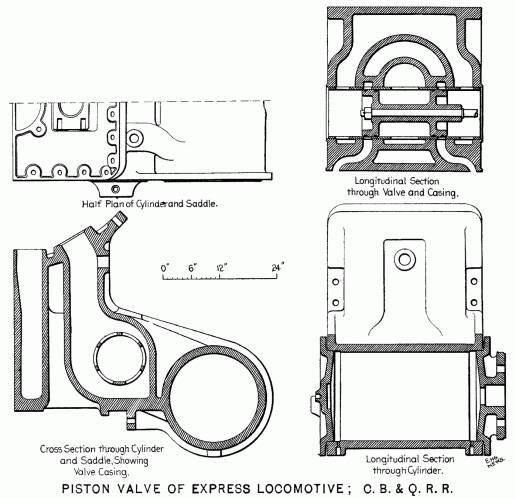
The wheels have cast steel centers, those of the driving, wheels
being 6 ft. 6 ins. diameter, and the tires are secured by shrinkage
and retaining rings. The driving-wheel tires are of cast steel,
38ins. thick and 52
ins. wide, both pairs being flanged. The Westinghouse-American
outside equalized brake is fitted to the driving, trailing and
tender wheels, and is operated in connection with the Westinghouse
train brake, a 92-in. brake-pump
being used. The train air-signal is also fitted.
A special feature of this engine is the six-wheel tender, with
plate frames, this having been adopted by the C., B. & Q.
R. R. as an experiment to ascertain whether there is any advantage
in European practice in this respect. The three-cylinder mogul
engines of the Erie & Wyoming Valley R. R. (Eng. News, Feb.
7, 1895), as well as, one or two of the Pennsylvania R. R. express
engines, have six-wheel tenders. On the other hand, some of the
English papers and engineers are advocating the use of the American
tender on two four-wheel trucks for the heavy express engines
hauling heavy trains long distances.
This tender has a tank of 4,000 gallons capacity, with
4 plates for top, inside and
bottom, and 3-16-in. plates for the outside, put together with
7-16-in. rivets. The tank is of U or horseshoe shape, with
an inclined floor for the coal space, and rests upon a steel frame.
The wheels have wrought iron centers and steel tires, and the
axles have outside journals, the boxes working in pedestals. A
railing extends beyond the tank to protect the footplate, and
there is a cab over the tender deck.
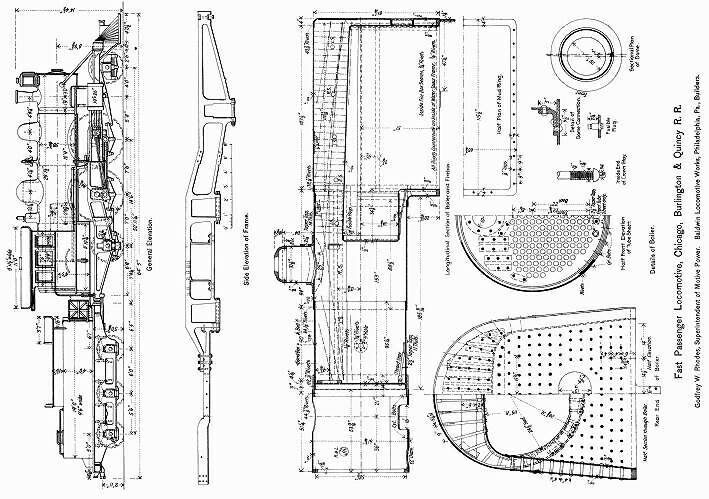
Contents Page | Build a Locomotive
|







